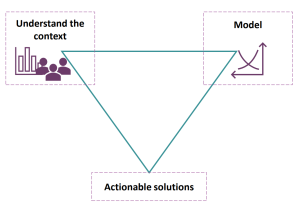Elective Recovery: understanding targets and finding opportunities to increase activity
April 6, 2023 • Reading time 2 minutes
Elective recovery targets – a confusing landscape
The first quarter of 2022 saw the launch of NHSE’s elective recovery plan, setting out a trajectory to carry out 30% more elective activity by 2024/25 than before the pandemic. The first goalpost was set at achieving a 10% increase in completed pathways during 2022/23, with additional funding available for providers delivering 4% more valued-based activity compared to 2019/20. However, as of October 2022 the targets were unmet by the majority of Trusts.
A specialist provider in London reached out to Edge Health to gain a deeper understanding of targets in practical terms and scope potential solutions.
Deep insights to model solutions

Our strategy had two tangible targets:
- Understand the issue deeply through multiple on-the-ground interviews, capturing staff’s key concerns, and evaluate current and past activity to reflect NHSE’s value focus.
- Analyse past and present valued activity to produce a user-friendly model to assess how much activity by point of care and team would be required to meet NHSE’s targets.
Clarifying the meaning of valued activity and the 104% vs 110% targets was central to the success of our work.
Essentially, a 104% valued activity target was set to avoid an achievement of the 110% target exclusively through reducing outpatient follow-ups and completing more referrals in primary care. Tariffs are applied to obtain valued activity, so that inpatient elective pathways are far more valuable than day cases and outpatients. In our client’s case, despite excelling at completing outpatient pathways, they were unable to meet the targets due to the value-weighting placing more importance on inpatient activity.

The technical and clinical expertise of our team was key to uncover the key reasons behind our client’s difficulty in meeting elective recovery targets. Particularly, we identified a significant increase in patient complexity leading to prolonged case duration in theatre, contributing to a reduced throughput.
Conversations with staff highlighted concerns over staff changeover with a shift towards less senior team members, as well as low morale following COVID-19 and NHS pension concerns affecting the appetite for overtime work. Our analysis also revealed significant losses in theatre staffing, mirrored nationwide, since 2019/20.
We proposed actionable and achievable recommendations spanning various opportunity areas and evidenced their resulting effect on activity recovery, to support prioritisation and a focus on the solution, not just the problem.
A local team empowered to tackle elective recovery
Our client gained clarity on elective recovery target requirements and the reasons contributing to the activity gap. This empowered the local team to look for solutions such as team expansion where needed and tackle elective activity through addressing theatre scheduling, fallow activity and utilisation.
 Back to News & Insights
Back to News & Insights